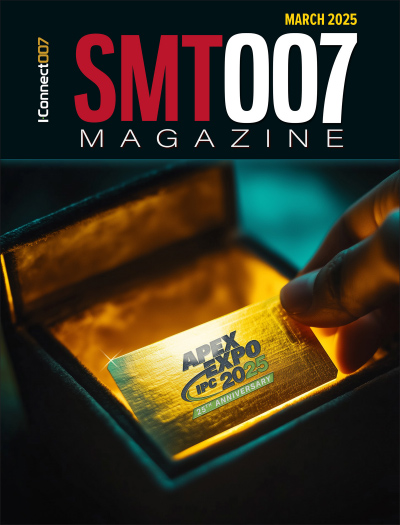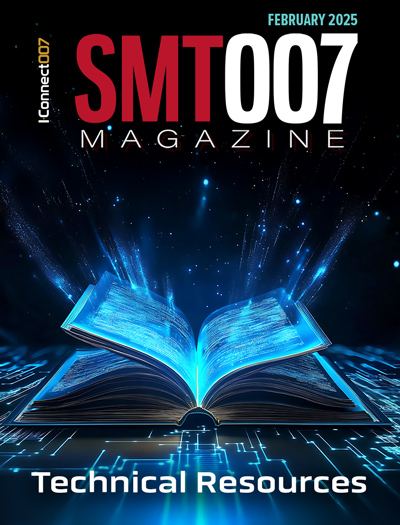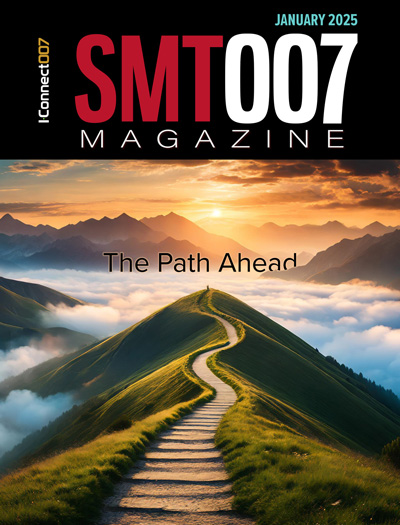-

-
News
News Highlights
- Books
Featured Books
- smt007 Magazine
Latest Issues
Current Issue
IPC APEX EXPO 2025: A Preview
It’s that time again. If you’re going to Anaheim for IPC APEX EXPO 2025, we’ll see you there. In the meantime, consider this issue of SMT007 Magazine to be your golden ticket to planning the show.

Technical Resources
Key industry organizations–all with knowledge sharing as a part of their mission–share their technical repositories in this issue of SMT007 Magazine. Where can you find information critical to your work? Odds are, right here.

The Path Ahead
What are you paying the most attention to as we enter 2025? Find out what we learned when we asked that question. Join us as we explore five main themes in the new year.
- Articles
- Columns
Search Console
- Links
- Media kit
||| MENU - smt007 Magazine
Back to School With Jonathan Studinka
October 16, 2024 | Andy Shaughnessy, Design007 MagazineEstimated reading time: 3 minutes
At the Anaheim Electronics & Manufacturing Show, I spoke with Jonathan Studinka, a student in John Watson’s PCB design class at Palomar College. In this interview, Jonathan shares his experience, highlighting how John’s class has broadened his understanding of PCBs and sparked his interest in mechatronics. Despite having no prior electronics training, Jonathan says he finds the coursework manageable by taking it step by step.
Andy Shaughnessy: Jonathan, tell us about your PCB design class at Palomar College.
Jonathan Studinka: It’s opened my eyes to many things about PCBs and the world we live in. The device recording this conversation has a PCB in it, so without that PCB, this interview couldn't happen. I wanted to go to the mechanical side at first. But after taking John Watson’s class, I want to look more into mechatronics, combining mechanical and electrical.
Shaughnessy: You mentioned that you have a background in AutoCAD, correct?
Studinka: Yes, I've learned AutoCAD. At my old company, we built water filtration systems for municipalities around San Diego County, and I helped them design a frame for a mixer that would sit in a tank holding up to 10 million gallons.
Shaughnessy: That's pretty cool. What led you to take Watson’s class?
Studinka: Basically, I was just seeing what was out there. I want to do something hands-on, building something from nothing.
Shaughnessy: How far along are you in the coursework?
Studinka: We're six weeks in. It's a very overwhelming thing when you haven't had a background in PCB, not having touched anything about it before. So, I eat the elephant a few bites at a time.
Shaughnessy: Did you have any prior electronics training?
Studinka: No, no electronics training at all. I thought I would go into construction work, but quickly decided that was not a path for me. We had a construction class in my high school. I realized I didn’t want to go down that path.
Shaughnessy: Well, Watson certainly has a jobs pipeline. He says companies ask him for candidate referrals every day.
Studinka: That would be amazing to go from a class right into a job.
Shaughnessy: Since you already have AutoCAD experience, you could be the part-time mechanical guy instead of having to call the mechanical guy.
Studinka: I think it would be cool to wear multiple hats.
Shaughnessy: Would you recommend this class?
Studinka: I would, absolutely. Give it a shot; you don't know until you try, even if you feel like you're in over your head. John takes you through every single step you need to know. I often think that if I do this and this, what will happen to my design? We're just finalizing the schematic, and even in our lab, I was playing around with different pins and this and that, seeing what it would do. I actually was able to fix a few issues just by playing around and seeing what could happen.
Shaughnessy: It is an art. Some people say it's also like a puzzle. Do you like to do puzzles?
Studinka: Yes, it is like a big jigsaw puzzle where the shapes do not always fit together properly, but they go next to each other.
Shaughnessy: That's a good way to look at it. Any final thoughts?
Studinka: No, just get into PCB design, and you can start with this John’s class at Palomar College.
Shaughnessy: Thank you, Jonathan. Glad to see young people coming into PCB design again.
Studinka: Thank you for the opportunity.
Suggested Items
MicroCraft to Unveil Three New Models at IPC APEX EXPO 2025
03/12/2025 | MicroCraftMicroCraft, a global leader in PCB testing and precision inkjet printing solutions, is set to showcase three cutting-edge models at IPC APEX EXPO 2025 at the Anaheim Convention Center March 18-20 in booth #4105. Each model represents the latest advancements in speed, accuracy, and automation across MicroCraft’s three product lines.
Ventec International Group Announce Launch of VT-47LT IPC4101 /126 Prepreg for HDI
03/12/2025 | Ventec International GroupVentec International Group announce launch of VT-47LT IPC4101 / 126 Prepreg. Are Microvia Failures Plaguing Your HDI Any Layer Designs? High-density interconnect (HDI) designs are pushing the envelope - higher layer count HDI relies on complex microvia designs: skip vias, staggered microvias, and stacked microvias in sequential laminations.
TCT Circuit Supply and Electra Polymers Announce New Strategic Partnership
03/12/2025 | Electra Polymers LtdTCT Circuit Supply (TCS) is excited to announce a new strategic partnership with Electra Polymers, a global leader in advanced specialty polymer products
INEMI Sessions at IPC APEX EXPO Focus is on Board Assembly and PCB & Laminates
03/12/2025 | iNEMIIf you plan to attend the upcoming IPC APEX EXPO in Anaheim, California, be sure to add the INEMI sessions to your calendar. We will have two forward-looking sessions — one on PCB and Laminates and the other on Board Assembly.
Global Sourcing Spotlight: How Global Sourcing Drives Innovation
03/12/2025 | Bob Duke -- Column: Global Sourcing SpotlightSomeone once told me the more you meet and work with people, the more you’ll learn and, most importantly, the more it will spur more innovation. Innovation is, of course, the lifeblood of success. Companies constantly seek ways to stay ahead, remain competitive, and deliver value to their customers.


